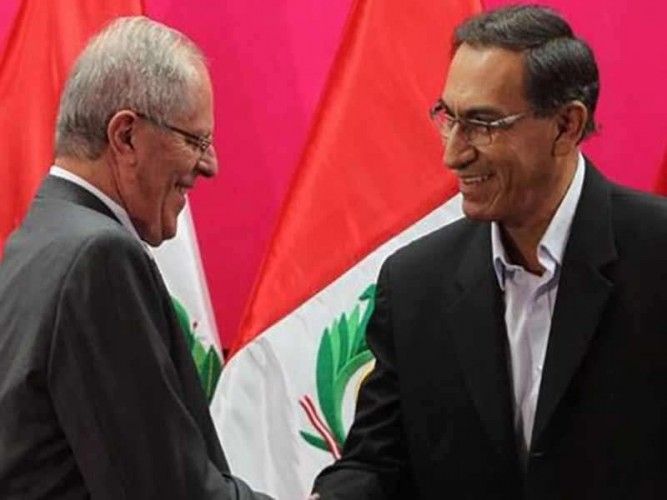After months of political crisis Peruvian President Pedro Pablo Kuczynski (PPK) handed in his resignation on Wednesday, March 21, 2018 avoiding a second impeachment vote against him which most probably would have resulted in his dismissal by the Peruvian Congress.
PPK, a highly respected economist and invest banker, who worked among others at the World Bank and the International Monetary Fund before entering Peruvian politics, served as Minister of Energy and Mines in the early 1980s under President Fernando Belaúnde Terry, and as Minister of Economy and Finance and Prime Minister under President Alejandro Toledo in the early 2000s.
While Kuczynski only placed 3rd in the presidential elections in 2011 (Ollanta Humala won the runoff election against Keiko Fujimori, daughter of former controversial president Alberto Fujimori), in 2016 he narrowly defeated Keiko Fujimori and was sworn in as 66th Peruvian President on July 28, 2016.
But his presidency unfortunately was doomed from the beginning. Even though it seemed that PPK was trying hard to bring the country together and forward, deepen international relations, fight corruption, initiate useful changes, better the economic and social situation of many and integrate indigenous and minorities, he mostly was only supported by Peruvians living in the city.
In the rural areas of the Peruvian highlands and jungle however he and his US American wife Nancy Lange were regarded with suspicion; some go as far as speaking about “reverse racism” as PPK, although born in Lima, had German parents who fled the Nazi regime in the 1930s, and held next to his Peruvian as well the US citizenship which he renounced in 2015 before running for presidency. So, he and the Peruvian First Lady were never seen and accepted as a “real” Peruvian.
Kuczynski’s biggest obstacle however was that he and his party Peruanos Por el Kambio (Peruvians for Change) didn’t have a majority in congress. The Peruvian Congress is controlled by the Fuerzo Popular (Popular Force party) under his opponent Keiko Fujimori who seemingly couldn’t overcome her defeat in the presidential elections and has her own power-political interests. Countless bills and draft laws with changes for the good of the country brought into congress by PPK were blocked, numerous respected ministers forced from his cabinet on flimsy grounds with votes of no confidence making governing difficult.
Then last year the former president, who from the beginning took a tough approach on cracking down on corruption, himself was accused of being involved in the corruption scandal around Brazilian construction company Odebrecht which he vehemently denied. After PPK had to admit that one of his consultant firms has received advisory fees (no bribes) from Odebrecht while he was Peru's Minister of Economy and Finance between 2004 and 2005, Keiko Fujimori and her Fuerzo Popular party started impeachment proceedings against Kuczynski in mid-December due to “moral incapacity” to lead the country. He survived the vote thanks to the support from a few renegade Fuerza Popular members; among them Kenji Fujimori, Keiko’s younger brother. When a few days after the vote Alberto Fujimori, father of Keiko and Kenji and former controversial Peruvian president, who served a long prison sentence for corruption and human rights violations, was pardoned by Kuczynski, everything pointed to an agreement.
Even though all involved promised to work together for the better of the country, the situation didn’t calm down. New scandals and evidence allegedly supporting the claims about PPK’s involvement in corruption surfaced. A second impeachment proceeding was initiated – once again with Keiko Fujimori and the Fuerza Popular party as driving force – and the vote set for March 22, 2018. Two days before the vote the then still president made clear that he wouldn’t resign and face the impeachment process for a second time. A day later the so-called “Kenji-videos” went viral, showing how PPK’s allies tried to convince members of the Peruvian Congress to vote against the impeachment by offering public construction projects. This was the last nail in Kuczynski’s coffin.
The last thing he actually could to do under the circumstances was resign. On March 21, 2018 the Peruvian President informed in a televised address to the nation that he handed in his resignation letter to the Peruvian Congress, in which he declared his stepping down from office. He explained his decision with the difficult situation that unfairly makes him look guilty and his belief that under these circumstances his resignation is in the best interest of the country.
The Peruvian Congress accepted PPK’s resignation a day later and as stipulated by the Peruvian Constitution, First Vice-President and Peruvian Ambassador in Canada, Martin Vizcarra took over as new Peruvian President. After the swearing-in ceremony, he announced to introduce his completely new cabinet in a few days that will put Peru first and tries to overcome conflicts. He as well made clear that he will continue to fight corruption in the country and improve the education system.
In the meantime, the Peruvian Prosecutor’s Office searched two homes of Pedro Pablo Kuczynski in Lima as part of investigations regarding the former president’s involvement in corruption and money laundering. Additionally, he is not allowed to leave the country.
The next weeks and months will show how the political situation a la Latin American soap opera produced in Peru continues.


